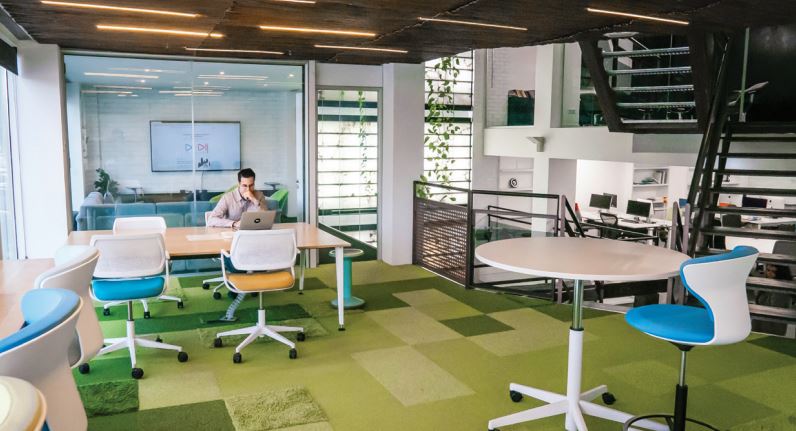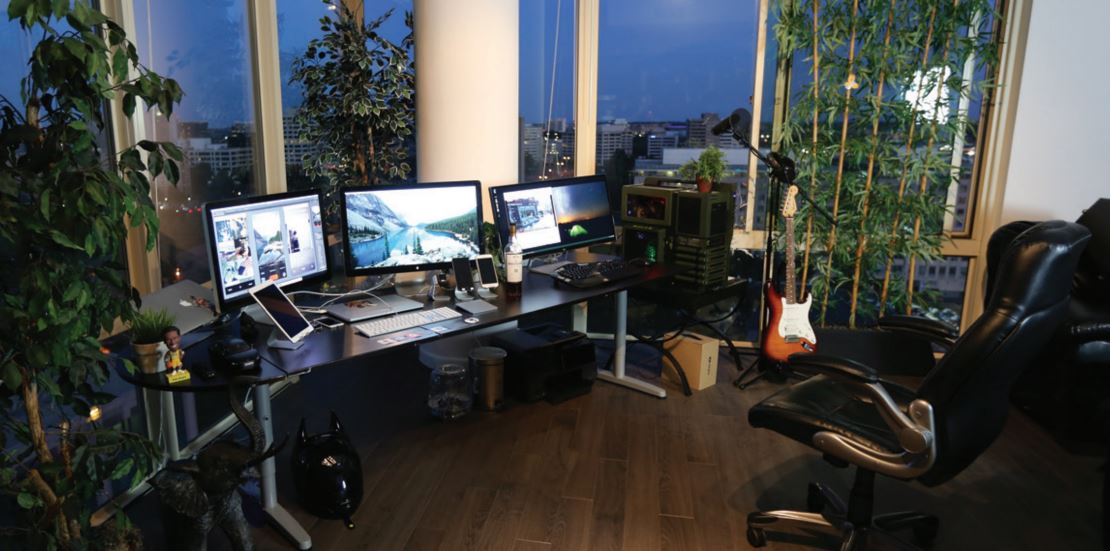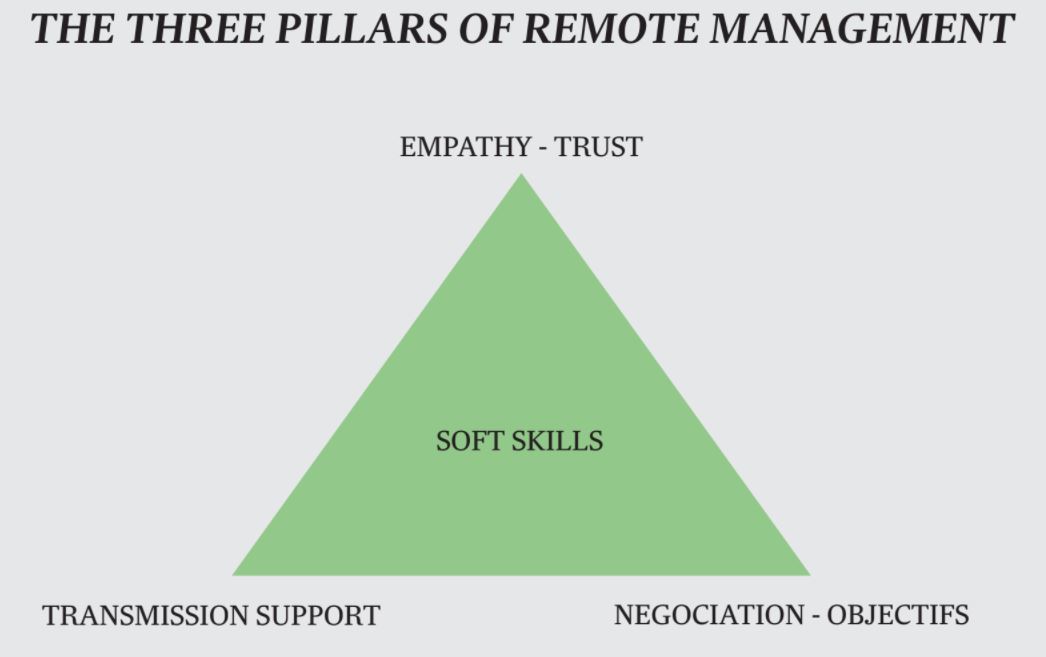An acceleration of the changes brought by the health crisis: What is the new purpose of workspaces?
Sponsored Article by Ergonoma
“Personal technology and digital connectivity had advanced so far and so fast that people had begun to ask, «Do we really need to be together, in an office, to do our work?» We got our answer during the pandemic lockdowns. We learned that many of us don’t actually need to be collocated with our colleagues on-site to do our jobs. Individuals, teams, entire workforces, can perform well while working remotely. This brings up new questions: Are all-remote or majority-remote organizations anticipating the future of work? Is this what the future of work looks like?”

An economic, social, and health crisis reshuffles everyone’s opportunities. Resilience, as we mention it in these times of uncertainty and profound change, is more a way of moving forward with the stigma of lived situations, of going beyond them, of emancipating oneself from them, without returning to the world as we knew it before. The upheavals in our habits, especially in
our conditions and ways of working, have pushed us to change much more rapidly and significantly than advanced technology, equipment, and cultural changes have in the two previous decades.
Trends that we could identify in recent years have suddenly accelerated and unfolded due to new constraints. This is calling for a transformation in our ways of working that are unprecedented in companies’ scopes and in the haste with which they have been installed. We will analyze how underlying trends have asserted themselves, and what new changes have aggregated to them, before concluding if tomorrow’s world -which remains to be structured and stabilized- will be hybrid or not.
1. Underlying trends before the crisis
Before the emergence of a global pandemic and the generalized containment of the population in many countries, fundamental movements were observable, gradually transforming ways of working. Technologies slowly advanced and allowed remote work in terms of hardware and software, which started the era of teleworking more than 20 years ago. In France, the regulatory framework only recently made it compulsory to allocate teleworking days if the nature of the employee’s activities allowed it. However, this was generally reduced to one or two days per week, often subject to validation by the line manager. Telework remained marginal until 2019 and was neither systematic, widespread, nor regular. Nevertheless, during the social movements of January 2020, teleworking had begun to be implemented on a massive scale, although mainly to self-employed and other freelancers.
As the Fraunhofer Institute suggests in numerous studies, the evolution of working patterns -particularly those tending towards New Ways of Working – was moving towards allowing employees to work from any place, at any time, based on management by objectives (MBO). This concept of remote work or Work From Anywhere (WFA) was developed to bring employees closer to their customers, partners and markets and/or simply to increase their quality of life and their commitment. Reluctance to these developments was based on a lack of responsibility of employees or of organizational maturity, with management models based on face-to-face control, bureaucratic processes and the associated cultural issues that represented a real hindrance.
This debate now seems outdated: employees have proven their ability to ensure business continuity when working remotely. Fears related to the health situation added to the benefits derived from these circumstances – such as time and productivity savings – which are pushing organizations to consider teleworking as a new asset. A new challenge has risen, which lies in the decision of which model of telework, mobility, and work environment to implement.
Workspaces had also begun to evolve by encouraging flexibility of space (non-allocation of workstations or «flex-office») to stimulate collaboration and interaction. They were equipped as digital workplaces to facilitate remote collaboration through the use of tools to improve these exchanges and the placement of third places closer to where employees live. However, the crisis has benefitted these developments, suggesting that companies who are fully remote could be also sustainable. Major savings, especially in the context of unoccupied offices, would then be possible. However, some antecedents mitigate the relevance of promoting permanent and widespread telework. Indeed, companies such as Yahoo or IBM already implemented such models in the early 2010s and have since returned to a hybrid model, affected by the disengagement of many employees.
A new balance is therefore to be sought: more flexibility to work from anywhere has many advantages – whether in terms of productivity or well-being. However, permanent and massive teleworking presents many risks for organizations that could see their best talents identify less and less with the collective and feel increasingly isolated and lacking social ties. The question of how to maintain the feeling of belonging is key in this relocation of professionals. Moreover, the implementation of agile methods clearly characterizes this paradox: more flexibility is needed for all talents to express themselves, although professionals should be able to collaborate on creative activities on-site that remote tools cannot always promote. We are therefore facing two challenges. Firstly, the combination of these two worlds, establishing intentional choices of whether to carry out an activity face-to-face or remotely. And second, a more generic challenge, the re-thinking of companies’ cultural and organizational model.

2. Accelerated changes in uses and practices
New tools, often already available but not necessarily widely understood and used, have undergone sudden and widespread development. There are many examples of platforms that allow collaborations such as Zoom or Teams, and others which allow teams to edit documents together, to share information using the cloud and to solve doubts through Intranets. Email communications and question-and-answer robots are just additional examples of the many options available. Tools have been suddenly adopted, experimented with, perfected, and have thus transformed dynamics in the workforce.
On the other hand, new problems have arisen, fast and repeated video conference calls, added to noise disturbance on online conversations, disturb attendants. Desktop and meeting room activities are changing, we are no longer sure to have all meeting participants in the room, since some choose to stay at their desktops and other choose to work remotely. Workspace ecosystems, adapted to each activity, have found a new limit: they do not necessarily take into account this new hybridization of face-to-face and remote activities. This leaves us with an obvious solution: if the way we work has evolved significantly, our offices have to be redesigned to fit our new needs. But we should be able to ask ourselves which activities we want to
focus on in a shared space -the office-, and which ones we should focus on remotely. Furthermore, we need to adapt our work environment and culture to apply best practices in order to facilitate and optimize our tasks performances. By structuring our approach and intentionally adopting practices that promote performance and well-being, we can envisage a new ecosystem of common spaces that encourage social interaction and creativity, without neglecting other individual activities.
The cultural aspect is fundamental in this new context. The management model based on face-to-face and sometimes authoritarian control of employees has been forced to evolve, although it already seemed obsolete from an employee experience point of view. The concept of new leadership refers to a mode of management based on trust, negotiation of objectives, and the figure of support, assistance, and information relay of group leaders. Soft skills such as empathy and active listening are the base of a successful remote management as they enhance social understanding. But if leadership and organizational culture can evolve in this direction, human relations involved in a collective enterprise cannot be based solely on digital
interactions.
Although business continuity has been ensured despite employees working remotely, the growing demand for agility, knowledge sharing, and cross-functionality shows the need for a physical social link, a place to share, to check on the performance and the well-being of employees.

3. A hybrid world
The office continues to embody a social bond, the ultimate place to socialization, one of the three social institutions as defined by sociology. Although it is necessary -especially
in cases of confinement- to adopt online social rituals, in the medium- and long-term individuals are looking for IRL exchanges. Some creative activities, decision making, negotiation, brainstorming or co-construction, are more motivating, efficient, and productive when they take place face-to-face.
The trend identified by BICG in recent years in more than 20 countries already considers the tertiary office as a place for formal and informal collaboration rather than a place for control, access to information, or concentrated work. This has become even more evident now. Workspaces are tools that must provide added value for our collective activities and foster the social bond that will be the cement of teamwork cohesion. It must also provide the opportunity to concentrate or use certain tools when it is not possible for some employees to do so during their remote work. Moreover, since workdays are not homogeneous in their activities, it is always necessary to rely on an ecosystem of spaces adapted to the different work dynamics.
In a hybrid world, we work both face-to-face and remotely, but the key aspect of it is that most of our interactions can oscillate from one to the other, or even take place simultaneously. For instance, we can be present with a colleague, but collaborate with distant people, or work from any location and participate in a workshop whose dynamics take place in a given space gathering most of the participants. New tools and arrangements are therefore necessary, but it is the functioning of the workspaces and the dynamics promoted that should be strategically and
functionally defined beforehand. Work environments will promote collective performance if they present diversified spaces which are adapted to the activities, favoring exchanges and creations, and open to society and conviviality. They will be more effective if they are reconfigurable, flexible, and associated with a culture and processes oriented towards continuous improvement by
and for its users.
This workspace -conceptualized as a place of socialization-must be connected and offer an «augmented» experience to be attractive as it is mostly free to use or not. It can be distributed and replicated to bring the culture and identity of the organization back to life. It must also allow professionals to have more and to do more than in remote, thanks to tools adapted to the desired work dynamics: facilities, furniture, technologies, functional processes, and associated skills. To embody the human vision and the social function of a company or institution, participation of employees in the creation of the cultural and operational model of work is the guarantee of success. This also means being able to personalize certain elements that make
sense, that embody a project or a team, but also bringing these spaces to life through mechanisms of continuous improvement and innovation -for instance, by launching new initiatives or making clients participate in the creative process.
To make the most of situations such as the one we are going through, as well as to be prepared for current and future developments, organizations must adopt tailored hybrid work models, focused on their cultural and social DNA. To do this, social rituals can be held and a reflection that is part of an ambitious transformation project must be carried out. For its implementation, a deep co-construction with the collaborators, dealing with cultural, spatial, human, and digital issues, must be carried out in a structured and integrated way. By allocating uses to increased and distributed spaces and by capitalizing on their geographical location to get closer to professionals, organizations will not only be able to respond to today’s issues but will also meet the tomorrow’s challenges.

The office worker
He owns all the necessary technological tools, which fit in his briefcase. He has the ability to collaborate with anyone, anytime and anywhere. The organization provides him with the necessary equipment, helps him move his tools to his home, and offers him workspaces where he has a particular, enriching experience that motivates him to collaborate and engage with the team.
The flexible office
The manager’s office is available to everyone. The manager has priority when he is on site and needs to conduct confidential exchanges or practice individual management. The manager gets closer to his team and uses the different surrounding spaces according to his activities. If he or his team need to concentrate or collaborate at a distance, they will use the spaces specially designed for these activities. Thus, they will be able to work in a more private room when they have confidential communication meetings or in a meeting room if they would like to involve more people.
Capillary implantation
Large organizations often have a certain territorial capillarity thanks to a distributed geographical location. This can be used for commercial, operational, logistical or administrative needs. They can thus represent opportunities to recruit from further afield, to facilitate the improvement of employee well-being, to offer different living environments and to apply mobility and environmental policies by allowing employees to experiment on a particular site according to the needs of its projects and cross-functional tasks, as well as according to their lifestyle choices.
The places of socialization
These will be distributed spaces, hybrid offices, and headquarters organized in large campuses that encourage intellectual and collaborative emulation, open to society, customers and partners. Those places offer training and reflection, but above all a space to socially interact and connect with others.

